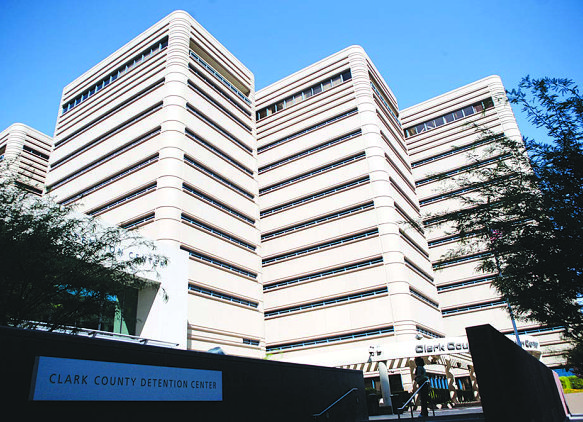
Metro Police, which operates the Clark County Detention Center (above), has added social workers to the mix of CCDC employees. The social workers coordinate with county services to make sure inmates who are unhoused head to a shelter with open beds when they are released from custody. The postincarceration care also includes coordination to ensure individuals continue with their medication.
As Las Vegans who are struggling with substance abuse or homelessness are booked into the Clark County Detention Center, they’ll be greeted not just by officers, but a different kind of face: a social worker.
For the first time, dedicated social workers will be stationed at the jail to provide services to the most vulnerable inmates to help stifle underlying issues causing incarceration.
The program began in June with just one social worker and this month expanded to two workers, with a goal of retaining at least four or five by the end of the year, officials said.
Deputy Chief Fred Haas, who oversees Metro’s Detention Services Division, said the inspiration for the program came after he toured jails in Denver and saw social workers operating in some of the facilities. He began looking to implement a similar system in Clark County to fit in with preexisting programs.
“If we expect somebody to change from the time they come in that door to the time they leave, we have to do something to help them get on their feet, get the tools they need to go out there and be successful when they leave,” Haas said.
The social workers are focused on homeless inmates enrolled in the county’s Medically Assisted Therapy program but do not have a transition plan after their release. There are about 95 enrolled inmates in the program, according to a recent presentation by Haas to the Clark County Commission.
“These are the folks who are truly being released with no plan in place, so that’s where we’re starting,” said Linsey LaMontagne, director of the Clark County Criminal Justice Coordinating Council.
Social workers coordinate with county services to make sure clients who are unhoused head to a shelter with open beds when they are released from custody. Postincarceration care also includes coordination to ensure individuals continue with their medication.
The transition plan also includes a “warm handoff” in which county or Metro officials, after coordinating with providers, will physically take those leaving incarceration to centers to ensure the newly released client receives help.
“We know if we just put them out the back door, they’re never going to get there,” Haas said. “We’ve tried Ubers, we’ve tried other things to get them there, and it’s just not as effective as that warm handoff.”
In 2023, inmates were transferred to mental health or substance abuse facilities nearly 1,300 times and placed on detox protocols for drug use almost 25,000 times, according to quarterly reports to the Clark County Commission.
Meeting with clients who are not only struggling with substance use but lack the resources to help themselves is a key part of helping them get back on their feet and reduce future drug use, officials said.
“When folks are leaving, if there’s no plan in place we see them coming back often, or they’re going right back to where they were and continuing to use,” LaMontagne said.
The social workers at the jail have already assisted over 60 MAT participants create plans, and LaMontagne is hoping that number reaches even higher as more workers join the ranks. For LaMontagne and Haas, a fully operational program would allow access to alternative resources almost immediately to produce better results in how people interact with the justice system.
“Can we potentially have a social worker right there in booking to say, ‘What do you need right now? Can we get you somewhere? Do you need transportation of sorts? Can we reach out to you tomorrow?’” LaMontagne said. “Whatever that looks like, that’s the end goal.”
With the program only three months in, long-term data on its efficacy has yet to materialize, but Metro and Clark County officials are confident in its ability to help the underserved — and understand that simply arresting offenders does little to solve larger problems.
"There’s a much higher success rate with these people coming through that style of program than there is if we just say, ‘good luck,’” Haas said. “Look at the people we house. They’re going to get released, right? We must do something to help them while they’re here.”
ayden.runnels@gmgvegas. com/702-990-8926/ @a_y_denrunnels

